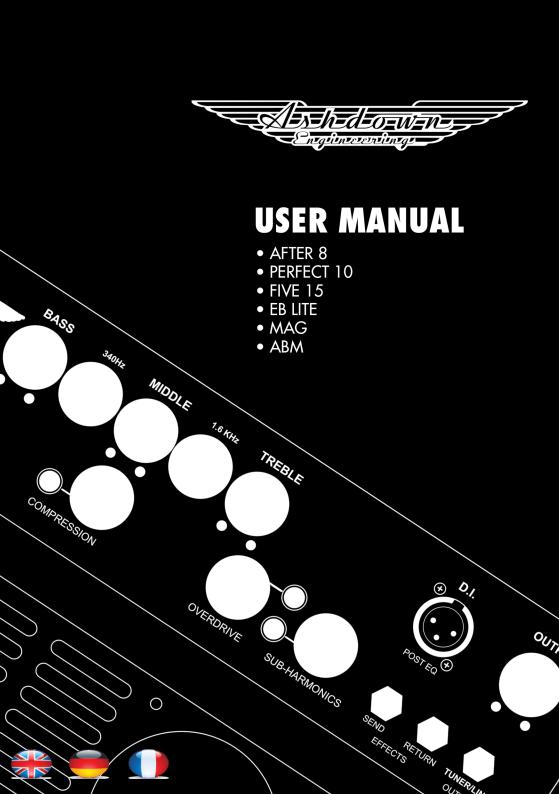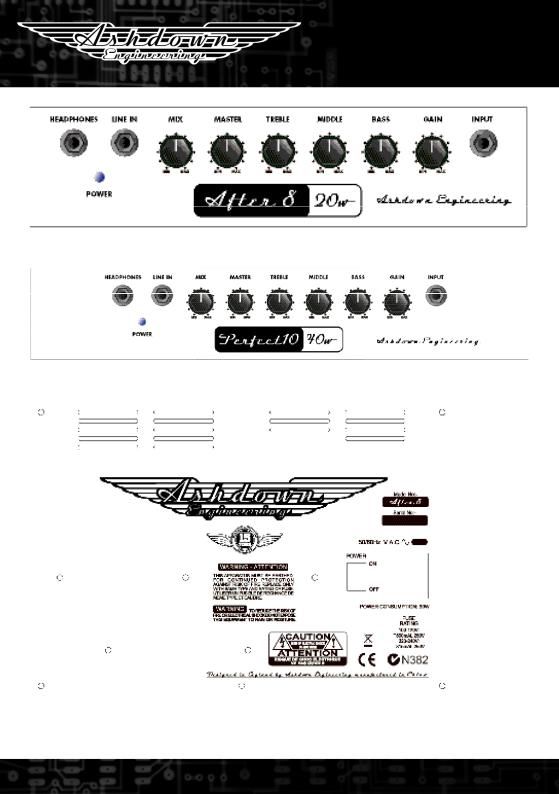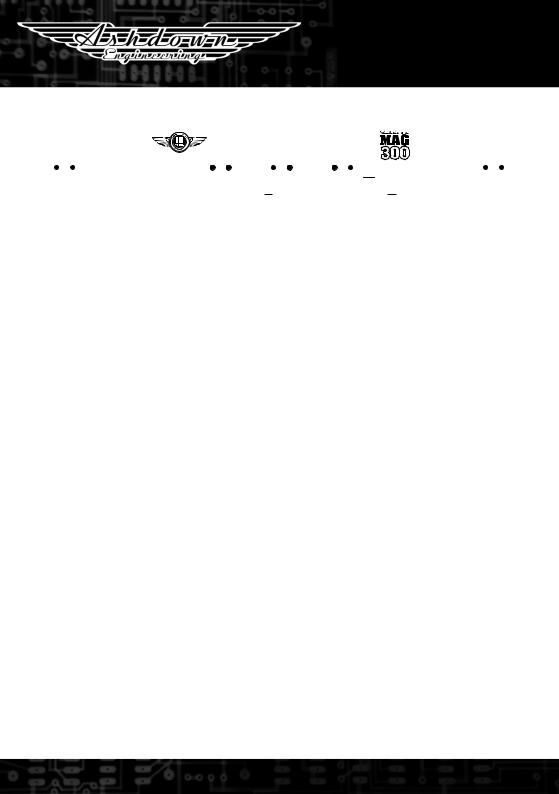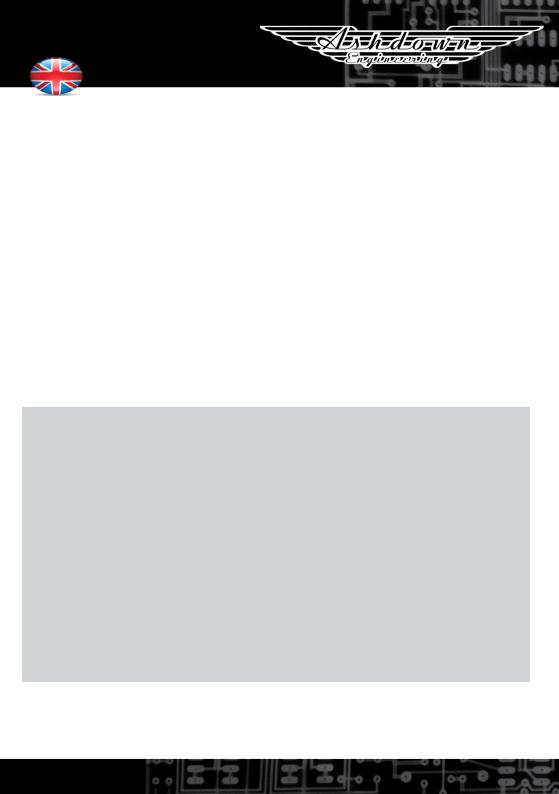Ashdown FIVE 15 MINI RIG User Manual [en, de, fr]


USER MANUAL
WELCOME
Thank you
Thank you for purchasing your Ashdown Engineering Amplifier and welcome to the family!
We really think you’ve made the right choice and know that this amplifier will give you years of great tone and service. It is a machine though and needs to be looked after, please read through this user manual which will help you get the most out of your new Amp and keep it running as long as some of our happiest and very famous customers.
REGISTER ONLINE
Please register this product online so we can make sure we give you years of customer support through our friendly in-house service centre.
Here is where you need to visit to register your product:
http://www.ashdownmusic.com/register
2 |
www.ashdownmusic.com |

Perfect 10 Demo Video:
www.ashdownmusic.com
www.ashdownmusic.com |
3 |

USER MANUAL
AFTER 8 / PERFECT 10
AFTER 8 Front Panel
PERFECT 10 Front Panel
Back Panel
Ashdown Amplifiers reserve the right to change specifications without notice. E & O E. All contents © Ashdown 2011.
4 |
www.ashdownmusic.com |

FRONT PANEL
Headhopnes
A headphone jack socket is provided to allow stereo headphones to be plugged into the amplifier for silent practice. This cuts out the main speaker when a jack plug is inserted.
LINE IN
A single balanced line input is provided for play along practice. Used in conjunction with the Headphones socket for silent practice. Also see, MIX.
MIX level
Set the level of your Backing Track by using the ‘MIX’ Rotery control provided.
MASTER level
Use the output level control to adjust the playing volume of the amplifier.
E.Q.
This passive EQ has bass, middle and treble tone controls.
GAIN
This adds tube emulated overdrive as a tube amp would when adding gain. From slight grit to full on overdrive.
Input
A single input jack socket is Provided for your instrument. This is a high impedance input designed to perfectly match the impedance of the pick-ups on a passive bass. It also has sufficient headroom available to allow active basses to be used. Use the input gain control to adjust for the sensitivity of your instrument.
Rear panel
Fused mains inlet socket
This is for connection of the unit to your countries mains power supply. Please ensure that the type and rating of mains fuse marked on the rear panel is used when this is replaced.
Power switch
the power to the unit is turned on with the rear panel power switch. A power led on the front panel will light to indicate that the amplifier is switched on.
after eight |
|
Output Power |
20watts rms into 8 ohms |
Input Impedance |
1 Meg ohm |
Input Signal Range |
100Mv to 10v |
E.Q. |
Passive Bass, Middle, Treble. |
Perfect ten combo |
|
Output Power |
40watts rms into 8 ohms |
Input Impedance |
1 Meg ohm |
Input Signal Range |
100Mv to 10v |
E.Q. |
Passive Bass, Middle, Treble. |
Specifications
Ashdown Amplifiers reserve the right to change specifications without notice. E & O E. All contents © Ashdown 2011.
www.ashdownmusic.com |
5 |

USER MANUAL
FIVE 15 / MINI STACK 100
Front Panel
INPUT
A single input jack socket is Provided for your instrument. This is a high impedance input designed to perfectly match the impedance of the pick-ups on a passive bass. It also has sufficient headroom available to allow active basses to be used. Use the input gain control to adjust for the sensitivity of your instrument.
INPUT CONTROL
The INPUT control sets the signal level through the preamp in conjunction with the INPUT LEVEL VU Meter. This is adjusted to give a reading of 0VU on the meter for average playing dynamics with occasional peaks into the red region. Please note that the setting of this may have to be re-adjusted after modification of the E.Q. controls.
E.Q.
This consists of BASS, MIDDLE and TREBLE controls with two sliders placed between each control. This can be used in a number of ways:
Firstly as a very simple Bass, Middle and Treble tone control section as found on older traditional amplifiers. This is done by leaving the two sets of sliders interposed between these controls set in their centre positions and using only the BASS, MIDDLE and TREBLE controls to alter the overall tone.
Secondly, if more control is required then the sliders can also be used to tailor the E.Q. in the regions between the main tone controls. This provides a very versatile Equalisation section, it is simple to understand and operate, yet provides a wide degree of variation. It retains the simplicity of a threecontrol tone section but provides the flexibility of a graphic equaliser.
LINE IN
This Jack input socket allows you to connect an external sound device (i.e Mp3 player, iPod etc.) using a cable (not supplied.)
Headphones
A headphone jack socket is provided to allow stereo headphones to be plugged into the amplifier for silent practice. This cuts out the main speaker when a jack plug is inserted.
MIX LEVEL
The MIX control blends the overall level of the external sound source.
MASTER LEVEL
The MASTER control adjusts the overall level of the amplifier. Adjust this for your preferred overall stage playing volume.
Ashdown Amplifiers reserve the right to change specifications without notice. E & O E. All contents © Ashdown 2011.
6 |
www.ashdownmusic.com |

Inputs |
|
|
High Input |
Impedance - 3.9M ohms |
Input range 150mv to 20v p - p |
Low Input |
Impedance - 10k ohms |
Input range 300mv to 40v p - p |
Effects Return |
Impedance - 22k ohms |
Input level 0dbu nominal |
Outputs |
|
|
Tuner Output |
Impedance - 10k ohms |
Level 0dbu nominal |
Effects Send |
Impedance - 22k ohms |
Level 0dbu nominal |
D.I.Output |
600 ohms balanced |
Level -20dbu nominal |
Speaker Outputs |
Minimum Impedance - 4 ohms |
|
Frequency Response |
-3db at 22hz and 25khz |
|
Equalisation |
|
|
Bass |
+/- 15db @ 100hz |
|
Lo Mid |
+/- 15db @ 340hz |
|
Middle |
+/- 15db @ 660hz |
|
Hi Mid |
+/- 15db @ 1.6Khz |
|
Treble |
+/- 15db @ 7khz shelving |
|
Signal to Noise |
Better than 80db (E.Q. Flat) |
|
Distortion |
Less than 0.5% Thd |
|
Output Power |
100watts RMS into 4 ohms. |
|
Specifications
www.ashdownmusic.com |
7 |

USER MANUAL
EB LITE 220
INPUT |
INPUT LEVEL |
BASS |
340Hz |
MIDDLE |
1.6 KHz |
TREBLE |
D.I. |
OUTPUT |
VU
BRIGHT
POST EQ
PASSIVE ACTIVE
INPUT |
DEEP |
EQ |
COMPRESSION |
SUB-HARMONICS |
SEND |
RETURN TUNER/LINE |
EFFECTS OUTPUT
Front Panel
Inputs
There are two choices of instrument input, these are marked passive and active. The passive input is high sensitivity and high impedance to suit passive bass instruments. The active input is much lower sensitivity and impedance to accurately match the signal from active bass instruments i.e. Those with a built in battery powered pre-amp.
Input control
The input control sets the signal level through the preamp in conjunction with the input level vu meter. This is adjusted to give a reading of 0vu on the meter for average playing dynamics with occasional peaks into the red region. Please note that the setting of this may have to be re-adjusted after modification of the E.Q. controls.
Deep
With this button in a fixed E.Q. is superimposed on the pre-amp to give a bass boost to the sound. This gives +8db at 50hz.
Bright
With this button in a fixed E.Q. is superimposed on the pre-amp to give a treble boost to the sound. This gives +10db at 10khz.
E.Q.
This button switches the equalisation section in or out i.e. the Bass, Middle and Treble controls and the two rotary controls placed between these.
Equalisation
This consists of bass, middle and treble controls with two more rotary controls placed in-between. This can be used in a number of ways:
Firstly as a very simple bass, middle and treble tone control section as found on older traditional amplifiers. This is done by leaving the 340hz and 1.6Khz controls set in their centre positions and using only the bass, middle and treble controls to alter the overall tone.
Secondly, if more control is required then the 340hz and 1.6Khz controls can also be used to tailor the E.Q. In the regions between the main tone controls.
This provides a very versatile equalisation section, it is simple to understand and operate, yet provides a wide degree of variation. It retains the simplicity of a three control tone section but provides the flexibility of a graphic equaliser.
Compression
Adding a small amount of compression gives a fat bottom end to the sound and allows a greater volume of amplification to be used without the playing peaks distorting the amplifiers output stage.
You will also find that this will add definition to your playing bringing out notes within a run more clearly as it evens out the dynamics of your playing. A large amount of compression can be used as an effect but it will tend to reduce the dynamics in your playing to such an extent that the volume of the note will be the same no matter how hard or soft you hit the string.
Compression also adds sustain to notes making them longer before they die away.
The compression level control adjusts the degree of compression applied to the bass signal. For this to function correctly the input level must be correctly set as described in the input control section above.
When the input level is correctly set there will be hardly any difference in volume between compression in and compression out. This is because the MAG automatically compensates for the reduction in level that would be apparent when compression is added by increasing the overall gain to restore the volume to its pre compression level, because of this you may notice an increase in background noise with high compression settings.
Compression is switched in/out with the push button adjacent to the compression level control.
Sub harmonics
This section produces sub harmonics an octave below the notes being played. The level of these sub harmonics relative to the straight bass sound can be adjusted using the level control.
This is very effective in thickening the sound and you will find in use that only a small degree of this lower octave is required to really fill out the sound and provide a character that is not possible by any other means.
The degree of sub harmonics is also dependant on the setting of the bass control.
Sub harmonics are switched in/out with the push button below and to the left of the sub harmonics level control.
Ashdown Amplifiers reserve the right to change specifications without notice. E & O E. All contents © Ashdown 2011.
8 |
www.ashdownmusic.com |

Direct inject ( d.I. )
A balanced d.I. Is provided on the front panel xlr socket. This provides a post E.Q. Post effects signal.
The output signal from this xlr socket is set to a level and impedance suitable for connecting directly into a balanced microphone input of a mixing desk for either direct injection into the pa system or for recording.
Effects send/return
A serial effects loop is provided at a level of 0db. The effects send and return sockets for this are on the front panel below the d.I. Socket.
The effects send socket can also be used as a line out socket if required. The signal path through the preamp is only broken when a jack plug is inserted into the effects return socket. The effects send is situated after the E.Q.
Tuner/line out
This output socket provides a line level signal that can be used either for a permanent connection to a tuner or a line output for connection to other power amplifiers and speakers.
Output level
The output control adjusts the overall level of the amplifier. Adjust this for your preferred overall stage playing volume.
Everything possible has been done to make these reliable, minimum service, high quality, long lasting powerful bass amplifiers.
We know you will appreciate the effort that has been put into the design and manufacture of this unit and you will be rewarded in your choice of bass amplifier by long life and reliability.
Inputs |
|
|
High Input |
Impedance - 3.9M ohms |
Input range 150mv to 20v p - p |
Low Input |
Impedance - 10k ohms |
Input range 300mv to 40v p - p |
Effects Return |
Impedance - 22k ohms |
Input level 0dbu nominal |
Outputs |
|
|
Tuner Output |
Impedance - 10k ohms |
Level 0dbu nominal |
Effects Send |
Impedance - 22k ohms |
Level 0dbu nominal |
D.I.Output |
600 ohms balanced |
Level -20dbu nominal |
Speaker Outputs |
Minimum Impedance - 4 ohms |
|
Frequency Response |
-3db at 22hz and 25khz |
|
Equalisation |
|
|
Bass |
+/- 15db @ 100hz |
|
Lo Mid |
+/- 15db @ 340hz |
|
Middle |
+/- 15db @ 660hz |
|
Hi Mid |
+/- 15db @ 1.6Khz |
|
Treble |
+/- 15db @ 7khz shelving |
|
Deep |
+ 8db @ 50hz |
|
Bright |
+ 10db @ 10khz |
|
Signal to Noise |
Better than 80db (E.Q. Flat) |
|
Distortion |
Less than 0.5% Thd |
|
Output Power |
220watts RMS into 4 ohms. |
|
Specifications
Ashdown Amplifiers reserve the right to change specifications without notice. E & O E. All contents © Ashdown 2011.
www.ashdownmusic.com |
9 |

USER MANUAL
MAG 300 / 600
INPUT |
INPUT LEVEL |
BASS |
340Hz |
MIDDLE |
1.6 KHz |
TREBLE |
D.I. |
OUTPUT |
VU
BRIGHT
POST EQ
PASSIVE ACTIVE
INPUT |
DEEP |
EQ |
COMPRESSION |
OVERDRIVE |
SUB-HARMONICS |
SEND |
RETURN TUNER/LINE |
EFFECTS OUTPUT
Front Panel
Inputs
There are two choices of instrument input, these are marked passive and active. The passive input is high sensitivity and high impedance to suit passive bass instruments. The active input is much lower sensitivity and impedance to accurately match the signal from active bass instruments i.e. Those with a built in battery powered pre-amp.
Input control
The input control sets the signal level through the preamp in conjunction with the input level vu meter. This is adjusted to give a reading of 0vu on the meter for average playing dynamics with occasional peaks into the red region. Please note that the setting of this may have to be re-adjusted after modification of the E.Q. controls.
Deep
With this button in a fixed E.Q. is superimposed on the pre-amp to give a bass boost to the sound. This gives +8db at 50hz.
Bright
With this button in a fixed E.Q. is superimposed on the pre-amp to give a treble boost to the sound. This gives +10db at 10khz.
E.Q.
This button switches the equalisation section in or out i.e. the Bass, Middle and Treble controls and the two rotary controls placed between these.
Equalisation
This consists of bass, middle and treble controls with two more rotary controls placed in-between. This can be used in a number of ways:
Firstly as a very simple bass, middle and treble tone control section as found on older traditional amplifiers. This is done by leaving the 340hz and 1.6Khz controls set in their centre positions and using only the bass, middle and treble controls to alter the overall tone.
Secondly, if more control is required then the 340hz and 1.6Khz controls can also be used to tailor the E.Q. In the regions between the main tone controls.
This provides a very versatile equalisation section, it is simple to understand and operate, yet provides a wide degree of variation. It retains the simplicity of a three control tone section but provides the flexibility of a graphic equaliser.
Compression
Adding a small amount of compression gives a fat bottom end to the sound and allows a greater volume of amplification to be used without the playing peaks distorting the amplifiers output stage.
You will also find that this will add definition to your playing bringing out notes within a run more clearly as it evens out the dynamics of your playing. A large amount of compression can be used as an effect but it will tend to reduce the dynamics in your playing to such an extent that the volume of the note will be the same no matter how hard or soft you hit the string.
Compression also adds sustain to notes making them longer before they die away.
The compression level control adjusts the degree of compression applied to the bass signal. For this to function correctly the input level must be correctly set as described in the input control section above.
When the input level is correctly set there will be hardly any difference in volume between compression in and compression out. This is because the MAG automatically compensates for the reduction in level that would be apparent when compression is added by increasing the overall gain to restore the volume to its pre compression level, because of this you may notice an increase in background noise with high compression settings.
Compression is switched in/out with the push button adjacent to the compression level control.
Overdrive
This is a valve/tube emulated overdrive that is variable from a slight ‘edge’ or ‘warmth’ through to a fairly aggressive overdrive/distortion effect.
The actual degree of overdrive applied to the bass signal is also dependent on the setting of the input level control. The higher this is set, the greater level of overdrive can be applied using the overdrives own rotary control.
Overdrive can be switched in with the push button above and to the right of the overdrive rotary control. The amount of drive applied to the overdrive circuit is adjusted using this rotary control.
The overdriven bass signal is applied in parallel with the dry bass signal to ensure you never lose the full bottom end from your bass. Overdrive is situated after the compression allowing for a sustained overdriven bass signal to be produced by adding a degree of compression along with the overdrive itself.
Ashdown Amplifiers reserve the right to change specifications without notice. E & O E. All contents © Ashdown 2011.
10 |
www.ashdownmusic.com |

Sub harmonics
This section produces sub harmonics an octave below the notes being played. The level of these sub harmonics relative to the straight bass sound can be adjusted using the level control.
This is very effective in thickening the sound and you will find in use that only a small degree of this lower octave is required to really fill out the sound and provide a character that is not possible by any other means.
The degree of sub harmonics is also dependant on the setting of the bass control.
Sub harmonics are switched in/out with the push button below and to the left of the sub harmonics level control.
Direct inject ( d.I. )
A balanced d.I. Is provided on the front panel xlr socket. This provides a post E.Q. Post effects signal.
The output signal from this xlr socket is set to a level and impedance suitable for connecting directly into a balanced microphone input of a mixing desk for either direct injection into the pa system or for recording.
Effects send/return
A serial effects loop is provided at a level of 0db. The effects send and return sockets for this are on the front panel below the d.I. Socket.
The effects send socket can also be used as a line out socket if required. The signal path through the preamp is only broken when a jack plug is inserted into the effects return socket. The effects send is situated after the E.Q.
Tuner/line out
This output socket provides a line level signal that can be used either for a permanent connection to a tuner or a line output for connection to other power amplifiers and speakers.
Output level
The output control adjusts the overall level of the amplifier. Adjust this for your preferred overall stage playing volume.
Everything possible has been done to make these reliable, minimum service, high quality, long lasting powerful bass amplifiers.
We know you will appreciate the effort that has been put into the design and manufacture of this unit and you will be rewarded in your choice of bass amplifier by long life and reliability.
Inputs |
|
|
High Input |
Impedance - 3.9M ohms |
Input range 150mv to 20v p - p |
Low Input |
Impedance - 10k ohms |
Input range 300mv to 40v p - p |
Effects Return |
Impedance - 22k ohms |
Input level 0dbu nominal |
Outputs |
|
|
Tuner Output |
Impedance - 10k ohms |
Level 0dbu nominal |
Effects Send |
Impedance - 22k ohms |
Level 0dbu nominal |
D.I.Output |
600 ohms balanced |
Level -20dbu nominal |
Speaker Outputs |
Minimum Impedance - 4 ohms |
|
Frequency Response |
-3db at 22hz and 25khz |
|
Equalisation |
|
|
Bass |
+/- 15db @ 100hz |
|
Lo Mid |
+/- 15db @ 340hz |
|
Middle |
+/- 15db @ 660hz |
|
Hi Mid |
+/- 15db @ 1.6Khz |
|
Treble |
+/- 15db @ 7khz shelving |
|
Deep |
+ 8db @ 50hz |
|
Bright |
+ 10db @ 10khz |
|
Signal to Noise |
Better than 80db (E.Q. Flat) |
|
Distortion |
Less than 0.5% Thd |
|
Output Power |
330watts RMS into 4 ohms. / 575watts RMS into 4 ohms. |
|
Specifications
Ashdown Amplifiers reserve the right to change specifications without notice. E & O E. All contents © Ashdown 2011.
www.ashdownmusic.com |
11 |
